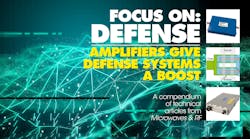Amplifiers are essential components in defense systems, whether to send radio signals or to energize the pulses needed for radar and electronic-warfare (EW) systems. Amplifier designers chase a somewhat elusive goal of trying to squeeze the highest efficiency possible from their designs, whether using vacuum tubes such as traveling-wave tubes (TWTs) or the latest gallium nitride (GaN) high-power solid-state transistors. For system-level specifiers, making an intelligent choice in a high-power amplifier (HPA) for a defense system benefits from having a solid basic education on the different types of HPAs and amplifier technologies currently available and a great deal of that information can be found in a digital e-book sponsored by MACOM, “Amplifiers Give Defense Systems a Boost.”
The e-book is highly focused on defense-related applications rather than commercial wireless communications systems. It covers the types of topics expected for military electronic systems, including the differences between amplifiers processing continuous-wave (CW) and pulsed signals, how solid-state and vacuum-tube amplifiers differ, and an essential exploration of the meaning of amplifier linearity and the type of defense-related applications where it is of extreme importance.
Admittedly, there are many different types of amplifiers that are used within defense-based electronic systems and this e-book is focused only on RF/microwave amplifiers, in both solid-state and tube forms. It does not cover audio amplifiers or any of the more exotic amplifiers involved in capturing and detecting short-duration signals, such as successive-detection log-video amplifiers (SDLVAs). But what it does cover regarding RF/microwave amplifiers is an understanding of achieving high gain and efficiency over the typically broad bandwidths found in EW and electronic-counter-measures (ECM) systems. It reviews the particularly challenging operating conditions in military systems, such as wide temperature ranges, shock, vibration, and humidity, and how both tube and solid-state amplifiers can be designed to maintain consistent performance even when thrust into the most hostile operating conditions.
The e-book serves as an excellent starting point for defense system integrators wanting to know more about the current state of RF/microwave power amplifiers.

